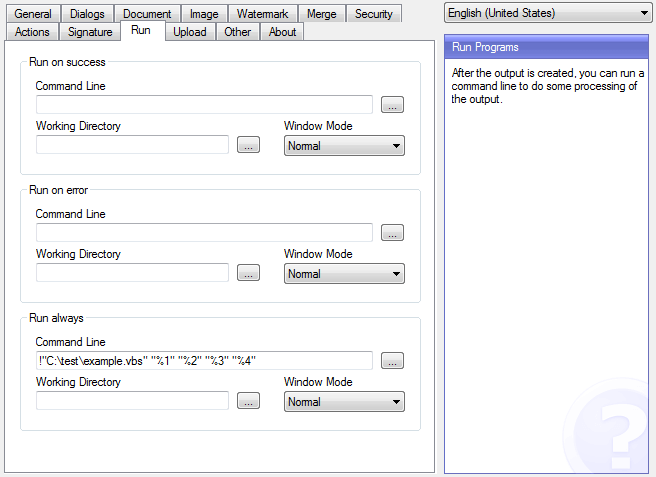Run a VBScript from the PDF printer after the document is created / PDF Printer
This small example will show you how to run a VB Script from the PDF printer after the pdf document is created. The principles used here are the same if you want to use it with the RunOnSuccess or RunOnError settings.
The VB Script
For this example, we have created a small VBScript that takes a number of parameters. These parameters are always passed to the programs specified under AfterPrintProgram, RunOnSuccess, and RunOnError.
Option Explicit Dim msg, args Set args = Wscript.Arguments msg = "Hello World!" & vbCrlf & vbCrlf msg = msg & "Document path: " & args(0) & vbCrlf msg = msg & "Pages: " & args(1) & vbCrlf msg = msg & "File count: " & args(2) & vbCrlf msg = msg & "Status file: " & args(3) & vbCrlf MsgBox msg
Use the VB Script
In order to make the printer run the script, we have to specify it in the AfterPrintProgram settings. This can be done in any of the configuration files or by using the Options Dialog found in the Windows start menu.

Note that the full path of the VB Script is surrounded by quotes to make sure it works if the path contains spaces. You should also note the "!" in front of the command. This will make the printer execute the command in Shell Execute mode, which is the same as if you run it using the run box found in your Windows start menu. If you leave out the ! then the printer will think the VB Script is an executable file type and fail.
If you do not want to run the script in Shell Execute mode or want to run the script in 32-bit mode on a 64-bit system then you can change the command to something like this.
c:\windows\syswow64\wscript.exe "C:\test\example.vbs" "%1" "%2" "%3" "%4"
Hopefully this will give you a head start on working with these features of the program.
